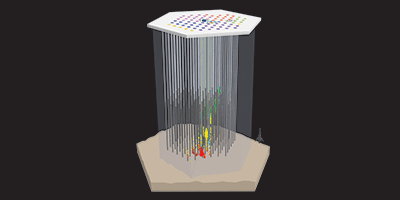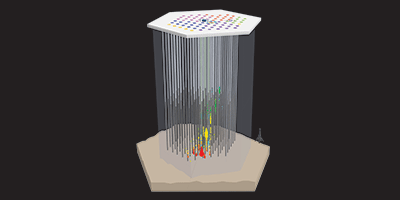A Year-Long Search for Dark Matter
Clues to the nature of dark matter could come from evidence that high-energy neutrinos are produced in the Sun. The neutrinos, according to certain dark matter theories, would result from particles called WIMPs (weakly interacting massive particles) becoming trapped by the Sun’s gravitational field and annihilating with each other. Now, the collaboration running the world’s largest neutrino telescope, the IceCube experiment at the South Pole, reports in Physical Review Letters its most comprehensive search to date for the predicted neutrinos.
IceCube consists of 5000 optical detectors suspended on 86 “strings,” each of which is buried deep in the Antarctic ice. Although neutrinos are infamously difficult to detect because they interact only weakly with matter, a few collide with the nuclei in the ice surrounding the detectors, generating relativistic particles that produce flashes of light (Cherenkov radiation). By timing the arrival of the light at different strings, the researchers can determine the trajectory of incident neutrinos. They then look for an excess of neutrinos (specifically, muon neutrinos) from the direction of the Sun, relative to the expected background from cosmic rays.
While IceCube was still undergoing construction in 2007, the collaboration used a partially completed array to search for dark matter annihilations in the Sun (see 21 May 2009 Synopsis). Their new analysis is based on a year of data taking that began in 2010 and included, for the first time, 13 closely spaced strings at the array’s center—a configuration that allowed them to search for WIMPs with masses below 50GeV/c2. The collaboration reports no muon neutrinos above background. Based on the result, the researchers are able to set the most stringent limit available on the value of the spin-dependent interaction between WIMPs and protons, one of the parameters that determines how likely the WIMPs are to be captured by the Sun. – Jessica Thomas





